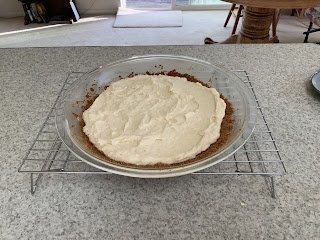 |
| Zinnias bloom until the first frost! |
Cover Crops
Cover crops, generally some variety of grains or legumes, can be a great benefit to the fertility of your soil. Also known as “green manures,” you sow the seeds in fall, the plants winter over, and you till in the mature plants in the spring.
It’s a good way to avoid having bare soil exposed to the winter elements. And the plants will add lots of organic material to your soil.
These mature grains or legumes can be a large biomass, though, and challenging to hand till. My best advice would be if you had a large space you could rototill, cover crops would be great to try.
 |
| Shelling pea seedlings, a mini-cover crop |
These seedlings won’t grow very much—probably only get a few inches tall, before they die off with the first hard frost. But in the meantime, the little pea plants will add a little nitrogen to the soil, and provide a bit of soil cover for winter!
Quick update later in October: the pea plants are now about 9 inches tall, and weathered our first frost well, which killed all the tomato and zucchini plants. So they’re continuing to improve the soil as we move deeper into fall.
Powdery Mildew
This is a fungus that generally shows up on some of your vegetable foliage, peas can be prone to powdery mildew, also plants in the squash family. One reason can be not enough watering. But if you have it show up in a well-watered bed, it could be the plant is simply nearing the end of its life cycle.
With squash plants, I just leave the plant in the ground, and let the killing frost do its job. Then I use the dead foliage as a bit of mulch on the soil, before adding another layer of mulch for winter.
Plants for Pollinators
Lots of students were interested in this one—after all, there’s an entire host of food plants with flowers, that will need pollinators to produce a crop!
Native plants are always a beneficial choice—many natives around here bloom in mid-spring, while it’s still pretty chilly, like Indian plum and red currant; native bleeding heart will bloom in a limited way through the summer.
One student sources wildflower seeds, tosses them right on the soil in early spring, then covers the seeds with cardboard, to prevent birds from scarfing up the seeds. After a few days, you removed the cardboard, and let the flower seedlings grow.
By summertime, you’ll have lovely wildflowers—one of her favorite is lupin. Keep in mind that a lot of wildflowers will self-seed quite prodigiously: daisies, lupin (they *really* spread themselves around!), foxglove; fireweed produces seed fluff plus underground runners. So I wouldn’t sow the wildflowers too close to your food crops!
 |
| Cosmos will self-seed too! |
Apple Trees: Dwarf or Semi-Dwarf?
One student asked which size you should plant. My experience is, we’ve had huge harvests from our dwarf-size apple trees—say, 300 apples per tree.
To me, semi-dwarf varieties seem much more manageable for the home food gardener. Our semi-dwarf trees will still produce over 100 fruits per tree—plus they’re easier to prune if you’re not very tall!
If you want to go even smaller, there are “mini-dwarf” varieties. Our Queen Cox is a mini-dwarf, and if well-managed, will produce 40-50 apples per year. Since the tree about as tall as I am, it’s easy to prune, and to thin as well. I only wish more of our trees were mini-dwarfs!
Peppermint “Smoothies”
Here’s a cool tip to deter mice, offered by one student—and a great way to use lots of mint! Blend a bunch of peppermint (yes, in your blender), and add a little water. Then you apply the mint slurry to where you’ve seen mice predation. (I saw a fair amount of gnawing on my blueberry roots this summer, and yup, that’s mice.) This is one I’m going to try today!
We also discussed compost quite a bit—you can find a lots of compost-making tips right here at the Little Farm blog… Just type in the search bar!










